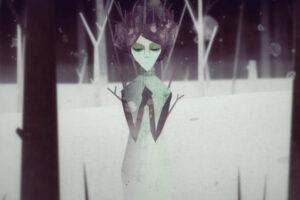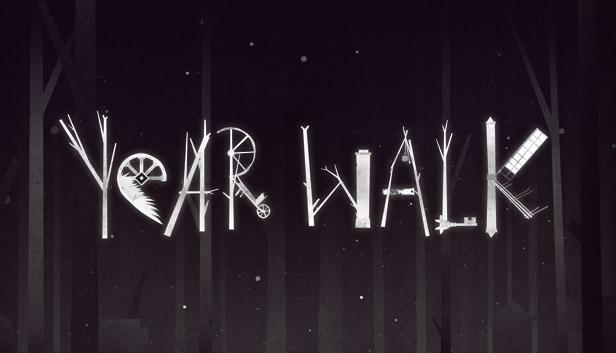Introduction
Year Walk is a point-and-click mystery game developed by the Swedish indie studio Simogo. Originally designed for mobile play, Year Walk has also been released on Wii U and PC (I played on the latter). Although there are no formal age guidelines, due to its unsettling nature and dark themes, I’d imagine its audience should be teens and up.
Central Argument
Year Walk’s narrative is integrated into its mechanics by the player enacting encyclopedia entries of various Swedish folklore. The environment, which shifts depending on the player’s progression through the narrative, guides the player to specific puzzles for each entry. I argue that Year Walk stands out because of its unique narrative structure that contains two primary arcs separated across time. Also, due to its lack of loops, players must constantly reframe how they approach puzzles, as they cannot rely on their previous solutions.
Analysis
After players learn that the successful completion of a Year Walk grants a vision into the future, they control the choices of Daniel Svensson as he embarks on this journey to see the future for him and his lover. Year Walk, as an embedded narrative, contains arcs related to each folk character, where the player must solve related puzzles, interact with the characters, and embody their stories from the encyclopedia entries.
The encyclopedia was the first mechanic I used when I played this game. It contained six entries: Årsgång (Year Walk, an ancient Swedish tradition), and several creatures/stories from Swedish folklore: the Huldra, the Brook Horse, Mylings, the Night Raven, and the Church Grim. The Huldra is the first mythological character that the players discover. She is described, by the encyclopedia, as a forest spirit who can act benevolently or maliciously. Early in the game, players encounter a woman holding a key and shrouded in branches, who quickly disappears.

Based on the description from the encyclopedia and the woman’s otherworldly appearance, the woman is implied to be the Huldra. The encyclopedia entry also notes that the Huldra is known to lure her victims into the forest with her voice and song. As the player wanders around the map, they can hear a woman’s voice in the background music as they try to find the woman. Her voice gets louder as the player gets closer to finding her, mirroring the folklore described by the encyclopedia.
The environment changes as the player progresses through the narrative. For instance, a new location is created after the newly-located Huldra leads the player to a clearing in the woods. This location serves as the next puzzle, where players must click two owls in the correct sequence to enter a tree containing the Huldra. There is never any instruction given to the players – they must intuit the logical next step. If they get stuck, there are a series of hints that help the players reach the answer themselves. I had to use this mechanism for the initial puzzle of finding the Huldra because my volume was fairly low and I couldn’t identify changes in the background music.
Mechanics aren’t shared between puzzles. For instance, there weren’t any subsequent puzzles where players followed voices to locate some puzzle or clue. Ruins used in one puzzle would never be repeated for a future puzzle. Therefore, when I played Year Walk, I constantly had to reassess my approach to each puzzle. However, there are a few interaction loops, such as basic point-and-click mechanics to move and tools such as the encyclopedia and map.

These loops create a skill chain that allows players to navigate efficiently, helping move the story and gameplay along. Players also familiarize themselves with recurring symbols and puzzle locations by repeatedly walking through the same areas.
Year Walk crafts its narrative through two major arcs. The first contains a series of sub-arcs that are completed whenever the player receives the key from each of the mythological creatures. Together, these sub-arcs depict the year walk of Daniel Svensson. Culminating in a revelation of a future where Stina meets a tragic demise, potentially at Daniel’s hands, this first arc delves into the experience of Daniel’s journey. The second arc shifts focus to Theodor Almsten, a modern academic researching Daniel’s year walk. Theodor’s narrative provides insight into Daniel’s fate as Theodor attempts to change the past. Together, these intertwined arcs form the backbone of Year Walk‘s narrative, offering players an immersive storytelling experience of two men connected across time.
Overall, Year Walk is a game rich in narrative crafted through the reuse of folktales, discovery enacted by exploring its environment, and challenges created by its unique puzzles. I enjoyed the diversity of the various puzzle mechanics and generally found them to be adequately challenging. However, the sound-related puzzles could’ve been reworked to be more solvable. These were some of the earliest puzzles in the game, but it might’ve been better to include them later once the player is more used to the background music and can better detect changes such as a woman singing. I also think they could be improved if there were additional visual cues for the hearing impaired (or tone deaf). Despite these difficulties, I enjoyed engrossing myself in this game and learning more about Swedish mythology.




